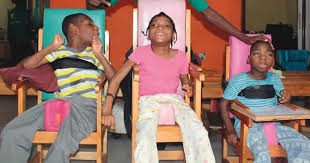Body pains, Erb’s Palsy, Stroke
Erb’s Palsy, Causes, Prevention and Treatment- Effective Physio, Abuja
Erb’s palsy is a paralysis of the arm. This is usually as a result of injury to the upper group of the arm’s main nerves, specifically the severing of the upper trunk nerves. These form part of the brachial plexus. These injuries arise most commonly, but not exclusively, during a difficult birth. The paralysis can be partial or complete. The damage to each nerve can range from bruising to tearing. It may resolve on its own within months. It may require rehabilitative therapy or surgery.
Erb’s palsy typically occurs when an infant’s neck is stretched to the side in addition to a downward force on the shoulder during a difficult delivery. Occasionally, Erb’s palsy occurs when a baby is larger than usual – making delivery difficult. This can occur due to poorly managed maternal diabetes or gestational diabetes.
Erb’s palsy can also occur in older patients when a fall or accident causes painful downward force to the shoulder.
Risk Factors of this condition in infants include the following :
- Breech Birth: Babies born feet-first are at a slightly at higher risk of Erb’s palsy because their arms may be raised and more easily injured from excess pressure.
- Gestational Diabetes: If blood sugar is not well-managed, babies may be born larger, making delivery more difficult.
- Improper Delivery / Use of Birthing Tools: During a complicated delivery, a baby may be pulled quickly and forcibly from the birth canal, causing injury to the neck and shoulder.
- Large infant/small maternal size: Delivery may be more difficult if the infant is larger than normal or the mother is particularly petite.
- Second stage of labor lasting over an hour: A long-lasting “pushing” stage may put an infant at a greater risk of Erb’s palsy and other brachial plexus injuries.
Signs and Symptoms
Erb’s palsy symptoms will vary depending on the type of injury done to the brachial plexus nerve. The symptoms in babies and adultsinclude:
- Numbness in one arm
- Paralysis of one arm
- Weakness in one arm
- Limited range of motion of the arm
Diagnosis
To determine whether one has Erb’s Palsy or not, physical examination is necessary. Thereafter, advanced diagnostic procedures can also help to effectively diagnose, proffer treatment and monitor the healing process. These procedures include
- Electromyogram (EMG)
- Imaging studies
- Nerve conduction studies
Prevention of Erb’s Palsy
Prevention they say is better than cure. When these necessary measures are put into consideration, the risk of the Erb’s Palsy will greatly reduce
- Advance planning: If the baby is larger than usual or in the incorrect position in the weeks leading up to the due date, planning in advance by the obstetrician to prevent Erb’s palsy should include ensuring qualified personnel are present in the delivery room. The proper use of birthing instruments and extractors, as well as induction of labor or Cesarean delivery if several risk factors are identified.
- Maternal healthcare: Good maternal healthcare during pregnancy, including avoidance or proper control of diabetes, can help prevent Erb’s palsy
Treatment of Erb’s Palsey
Most infants and older patients recover strength and movement in the affected arm within some months without needing special treatment. Some require medical attention which includes surgical and non-surgical treatment procedures.
- Surgical Procedures
The physician may recommend surgery to repair damaged nerves. The procedures include
- Nerve graft
- Nerve transfer
- Recovery: This involves after-surgery rehabilitation exercises to improve your strength and range of motion.
While surgery may be effective, the high risk involved and cost of the treatment procedure, make non-surgical treatments to be preferred.
- Non-Surgical Treatments
The most effective non – surgical treatment for Erb’s Palsy is Physiotherapy : Physiotherapy can help with the treatment of erb’s palsy. The physiotherapist will use a number of therapeutic techniques and range-of-motion exercises to promote healing.
Application of this means of treatment will go a long way in preventing joint stiffening in the shoulder, the elbow, the wrist and the hand.
For treatment, please visit Effective Physiotherapy & Fitness Clinic at No 2, D Ajumgobia Close, Kado Estate, Abuja.
Call: +234 803 436 5055 || +234 811 885 6060
Contact us on:
Address: No. 2 Ajumgobia Close, Kado Estate, Abuja
Call: +234811 885 6060 | +234 909 860 4470
Website: www.effectivephysio.com
Facebook: EffectivePhysiotherapyClinic
Instagram: Effectivephysiotherapy

